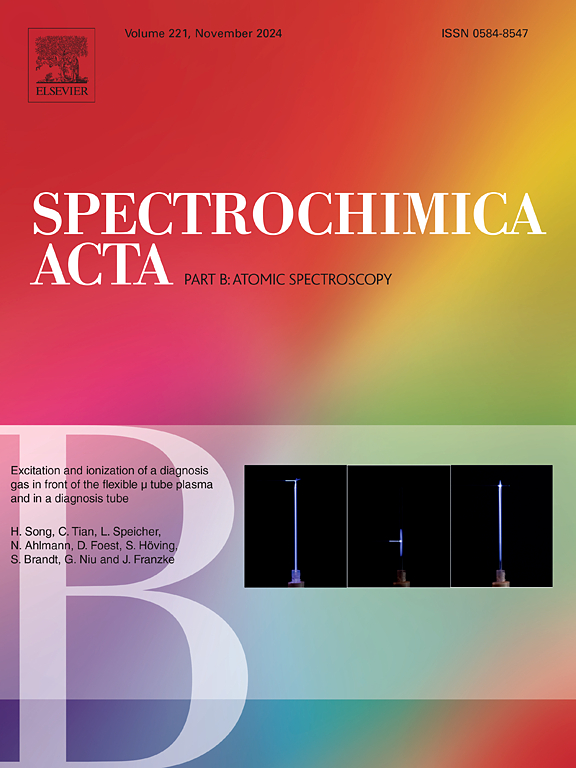Online analysis of coal particle flow by laser-induced breakdown spectroscopy based on pelletized coal calibration samples and feature-based transfer learning
IF 3.8
2区 化学
Q1 SPECTROSCOPY
引用次数: 0
Abstract
The application of laser-induced breakdown spectroscopy (LIBS) for directly measuring coal particle flow is an optimal choice for the actual industrial operations. With the objective of facilitating the detection of particle flow, we established a LIBS detection system coupled with the coal particle circulation bench, which can continuously and automatically provide particle flow samples for laser ablation. A quantitative analysis method for particle flow combining feature-based transfer learning was proposed, so a dual-mode optical LIBS module was designed and integrated into this system to obtain the spectral signals from different forms of coal samples (pellet and particle flow) through the same optical configuration. The spectral characteristics and the correlation between pellet and particle flow were firstly analyzed. Then a spectral correction method based on polynomial fitting was proposed to enhance the correlation between the pellet spectra and particle flow spectra. Finally, the feature space mapping method was introduced for improving the effect of feature transfer, and the model was trained on highly stable pellet spectra to perform a direct quantitative analysis of coal particle flow. The results demonstrated that the root mean square error (RMSE) for the analysis of calorific value, volatile matter, and ash content of particle flow was 0.757 MJ/kg, 2.630 %, and 3.034 %, respectively. This work provides a practical application scheme for on-line analysis of coal particle flow.

基于成球煤标定样品和特征迁移学习的激光诱导击穿光谱在线煤颗粒流分析
应用激光诱导击穿光谱(LIBS)直接测量煤颗粒流是实际工业操作的最佳选择。为了便于颗粒流的检测,我们建立了与煤颗粒循环工作台相结合的LIBS检测系统,该系统可以连续、自动地为激光烧蚀提供颗粒流样品。提出了一种结合特征迁移学习的颗粒流定量分析方法,设计并集成了双模光学LIBS模块,通过相同的光学配置获取不同形态煤样(颗粒和颗粒流)的光谱信号。首先分析了颗粒与颗粒流之间的光谱特征和相关性。在此基础上,提出了一种基于多项式拟合的光谱校正方法,增强了颗粒光谱与颗粒流光谱之间的相关性。最后,引入特征空间映射方法提高特征传递效果,并对模型进行高度稳定的颗粒谱训练,对煤颗粒流进行直接定量分析。结果表明,颗粒流热值、挥发物和灰分分析的均方根误差(RMSE)分别为0.757 MJ/kg、2.630%和3.034%。为煤颗粒流在线分析提供了一种实用的应用方案。
本文章由计算机程序翻译,如有差异,请以英文原文为准。
求助全文
约1分钟内获得全文
求助全文
来源期刊
CiteScore
6.10
自引率
12.10%
发文量
173
审稿时长
81 days
期刊介绍:
Spectrochimica Acta Part B: Atomic Spectroscopy, is intended for the rapid publication of both original work and reviews in the following fields:
Atomic Emission (AES), Atomic Absorption (AAS) and Atomic Fluorescence (AFS) spectroscopy;
Mass Spectrometry (MS) for inorganic analysis covering Spark Source (SS-MS), Inductively Coupled Plasma (ICP-MS), Glow Discharge (GD-MS), and Secondary Ion Mass Spectrometry (SIMS).
Laser induced atomic spectroscopy for inorganic analysis, including non-linear optical laser spectroscopy, covering Laser Enhanced Ionization (LEI), Laser Induced Fluorescence (LIF), Resonance Ionization Spectroscopy (RIS) and Resonance Ionization Mass Spectrometry (RIMS); Laser Induced Breakdown Spectroscopy (LIBS); Cavity Ringdown Spectroscopy (CRDS), Laser Ablation Inductively Coupled Plasma Atomic Emission Spectroscopy (LA-ICP-AES) and Laser Ablation Inductively Coupled Plasma Mass Spectrometry (LA-ICP-MS).
X-ray spectrometry, X-ray Optics and Microanalysis, including X-ray fluorescence spectrometry (XRF) and related techniques, in particular Total-reflection X-ray Fluorescence Spectrometry (TXRF), and Synchrotron Radiation-excited Total reflection XRF (SR-TXRF).
Manuscripts dealing with (i) fundamentals, (ii) methodology development, (iii)instrumentation, and (iv) applications, can be submitted for publication.

 求助内容:
求助内容: 应助结果提醒方式:
应助结果提醒方式:


